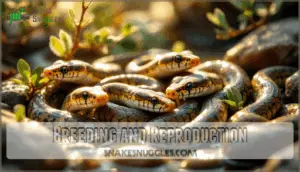This site is supported by our readers. We may earn a commission, at no cost to you, if you purchase through links.

People sometimes assume you need decades of experience or nerves of steel to care for a snake, but water snakes can surprise even cautious beginners. With the right setup and care, keeping one as a pet becomes less a danger and more an opportunity to watch nature’s subtleties up close—temperament, feeding quirks, the mysterious art of basking in a sunbeam that only they seem to notice.
Table Of Contents
- Key Takeaways
- Can Water Snakes Be Kept as Pets?
- Water Snake Characteristics
- Captive Care Requirements
- Handling and Temperament
- Breeding and Reproduction
- Acquiring and Keeping Water Snakes as Pets
- Frequently Asked Questions (FAQs)
- Can you keep a water snake as a pet?
- Are water snakes friendly?
- How long do water snakes live in captivity?
- How aggressive are water snakes?
- What are common water snake health issues?
- How to clean a water snakes enclosure?
- Can water snakes be kept with other pets?
- How to recognize a stressed water snake?
- Are water snakes suitable for homes with children?
- How much does it cost to keep one?
- Conclusion
Key Takeaways
- Water snakes can be kept as pets, but they need proper housing, regular care, and attention to legal and ethical considerations.
- These snakes aren’t naturally friendly and often show defensive behaviors, so gentle, consistent handling is important to reduce stress.
- A well-maintained enclosure with secure lids, clean water, and a varied diet is essential for their health and well-being.
- Responsible ownership requires long-term commitment, sourcing from reputable breeders, and regular monitoring for common health issues.
Can Water Snakes Be Kept as Pets?
Ever wondered what it takes to welcome a water snake into your home—or if they even make good pets in the first place? For beginner reptile keepers, water snakes offer a chance to learn the ropes, but pet ownership does bring captivity challenges.
Ethical considerations, proper enclosure setup and maintenance, and understanding snake temperament are just as important as enjoying their fascinating behaviors.
Water Snake Characteristics
Out in streams, ponds, and marshes from Ontario to Georgia, water snakes show what adaptability looks like. Their Physical Traits—stocky bodies, keeled scales, and distinctive blotches—help them blend into their watery homes.
You’ll spot a range of Color Changes as they age, from bold bands in young snakes to darkest brown or black in older adults. Activity Patterns shift with the season: they’re out basking by day in spring and fall, but often hunt at night during hot summers.
Communication Methods rely on chemical signals and body language, especially when water snake species defend territory or seek mates. These snakes are often found in urban and rural settings alike.
Captive Care Requirements
Caring for a water snake means setting up the right home, feeding routine, and health checks. There are a few practical things you’ll want to get right from the start.
Let’s break down what goes into a proper enclosure for these reptiles.
Enclosure
When setting up a home for your water snake, think of the enclosure as their own cozy blend of dry land and gentle shoreline. Choose a sturdy 30-gallon tank size, and focus on safety with a tight lid.
For smooth enclosure setup, remember:
- Substrate choice: newspaper or Astroturf.
- Heating options: UVB and under-tank heaters.
- Enrichment items: hiding spots and shallow water.
Diet
Once your snake feels at home, meal time is all about balance. Vary prey, feeding routines, and water for best results. Focus on these staples:
- Mix frozen rodents, earthworms, and feeder fish for prey diversity and to meet nutritional needs.
- Feed juveniles weekly; adult water snake feeding is every 7–14 days.
- Always offer fresh water for hydration access and safe digestion.
Snakes benefit from thawed or dead prey due to safety and humane considerations.
Health and Hygiene
For healthy, vibrant water snakes, think of their enclosure as both home and health clinic. Problems like skin issues, parasites, and zoonotic risks demand vigilance. Make routines second nature:
- Change water weekly and spot-clean daily for parasite control
- Deep-clean monthly to avoid water snake health issues
- Monitor for common illnesses—professional veterinary care addresses what regular enclosure cleaning alone can’t.
Handling and Temperament
Even for seasoned reptile keepers, mastering snake interaction and temperament takes patience and practice. Water snakes may come out of their shells with a little attitude—they’re quick to display defensive behaviors like striking, flattening their heads, or releasing musk. To guide yours toward docility, rely on gentle interaction and these proven taming methods:
- Start with short, regular sessions to build trust and minimize stress.
- Avoid interaction right after feeding or during shedding; that’s when stress and aggression spike.
- Move calmly—fast or jerky motions trigger more defensive behaviors.
- Create a calm, well-lit space and always wash hands before and after interaction.
With time, most water snakes acclimate, displaying friendlier social behavior.
Breeding and Reproduction
Once spring warms things up, water snakes waste little time diving into breeding seasonality. Males search out females, and with a little courtship, copulation takes place—sometimes with several rivals in pursuit. A gravid female carries her developing young for up to five months before an impressive live birth. Litter size can vary, but larger females frequently produce the largest number—sometimes thirty or more at once.
For reference, here’s the general sequence:
- Males pursue and court receptive females.
- Copulation occurs during spring’s peak.
- Gravid female incubates embryos internally.
- Live neonates are born, fully independent.
Neonate survival depends on careful separation and attentive monitoring during early life.
Acquiring and Keeping Water Snakes as Pets
Before you bring home one of these slippery swimmers, it pays to know what goes into being a responsible water snake owner. Start by checking the legal aspects of Acquiring and Keeping Water Snakes in your area—rules can vary, especially for some snake species.
Prioritize ethical sourcing by choosing breeders or dealers with a reputation for healthy animals and beginner suitability. Keep in mind that captive lifespan can exceed a decade, so consistent reptile care isn’t a quick commitment. Proper snake enclosure, a balanced snake diet, and patient snake interaction are essentials you can’t skip if you want your pet to thrive.
Responsible water snake ownership begins with ethical sourcing and demands a lasting commitment to attentive care, proper housing, and nutrition
- Verify local legal requirements first
- Source animals responsibly from trusted breeders
- Plan for ten or more years of care
- Prepare enriching, secure habitats
Frequently Asked Questions (FAQs)
Can you keep a water snake as a pet?
Like finding a diamond in the rough, water snakes make excellent beginner pets.
You can keep them with proper snake care, addressing housing challenges and legal restrictions while ensuring an appropriate snake enclosure setup.
Are water snakes friendly?
Water snake temperament is often defensive rather than affectionate, especially during interaction. While gentle care techniques may reduce aggression, their bite risk remains higher than some species, so interaction safety is important. Genuine domestication potential is limited for these snakes.
How long do water snakes live in captivity?
With attentive husbandry and regular annual care, Northern water snakes often reach an average longevity of 9 years in captivity.
Environmental enrichment, genetic predispositions, and a balanced diet are critical for optimizing snake health, maximizing water snake lifespan, and detecting early problems.
How aggressive are water snakes?
Though they can be feisty, especially around feeding or sudden movement, water snakes rely on defensive behavior—quick strikes and occasional bites.
Regular, gentle interaction and consistent taming techniques usually ease snake aggression and improve overall bite strength and strike accuracy.
What are common water snake health issues?
You’ll want to watch for shedding problems, scale rot, mouth rot, and respiratory infections. Parasite prevention matters, too. If obesity risks or odd skin problems pop up, act fast. Quick care helps water snakes rebound and thrive.
How to clean a water snakes enclosure?
Think of your snake’s enclosure like a fish tank—a little world needing routine care.
Schedule adherence is key: remove waste, clean and disinfect all surfaces, replace substrate, and refresh water regularly for best hygiene and water quality.
Can water snakes be kept with other pets?
Shared enclosures pose real risks—think predator/prey dynamics, species compatibility, and snake aggression in captivity. Even nonvenomous water snakes may lash out, transmit disease, or stress out other pets. Direct supervision is needed, but separation is safest.
How to recognize a stressed water snake?
Recognizing stressed water snakes starts with spotting stress behavior signs like erratic movements, hiding excessively, feeding refusal, or shedding issues.
Unusual aggression or rapid breathing often signal health issues linked to snake behavior, care and temperament challenges.
Are water snakes suitable for homes with children?
It’s odd but true: a nonvenomous snake can raise more child safety concerns than a cat.
Bite risk is real, so educate children early, supervise all snake interaction, and practice gentle, responsible ownership to avoid snake bite risks.
How much does it cost to keep one?
Initial setup costs for water snakes run $150–$300, with recurring expenses like food costs (feeder fish or frozen rodents), heating bills, and habitat supplies.
Veterinary care adds more, so long-term budgeting is key—reptile stores offer most necessities.
Conclusion
Remember, "curiosity killed the cat, but satisfaction brought it back." That saying rings true for those wondering if water snakes can be kept as pets. With knowledge, patience, and preparation, even cautious keepers gain deeper understanding—right in their own home.
Observe, adapt, and learn from your snake’s subtle signals. The experience invites you to re-examine assumptions and grow alongside a creature that rewards careful attention.
In the end, nature has a lot to teach if you’re willing to listen.
- https://instructions.hasbro.com/en-us/instruction/Elefun---Friends-Hungry-Hungry-Hippos-Game
- https://arachnoboards.com/threads/florida-banded-water-snake.103832/
- https://www.nal.usda.gov/legacy/awic/environmental-enrichment-nonhuman-primates-resource-guide-introduction
- https://www.livescience.com/52768-water-snake-facts.html
- https://www.mass.gov/info-details/learn-about-northern-watersnakes










